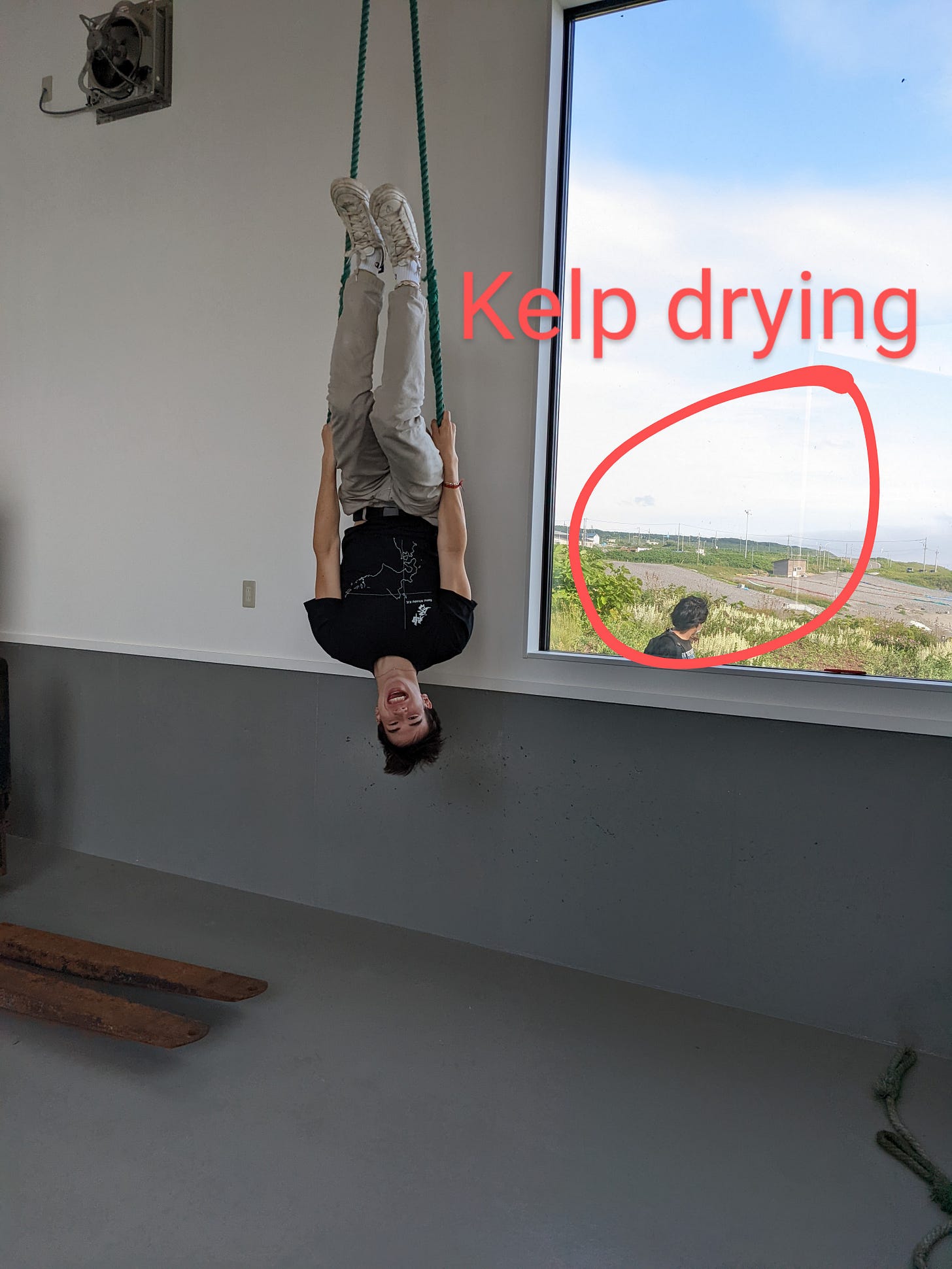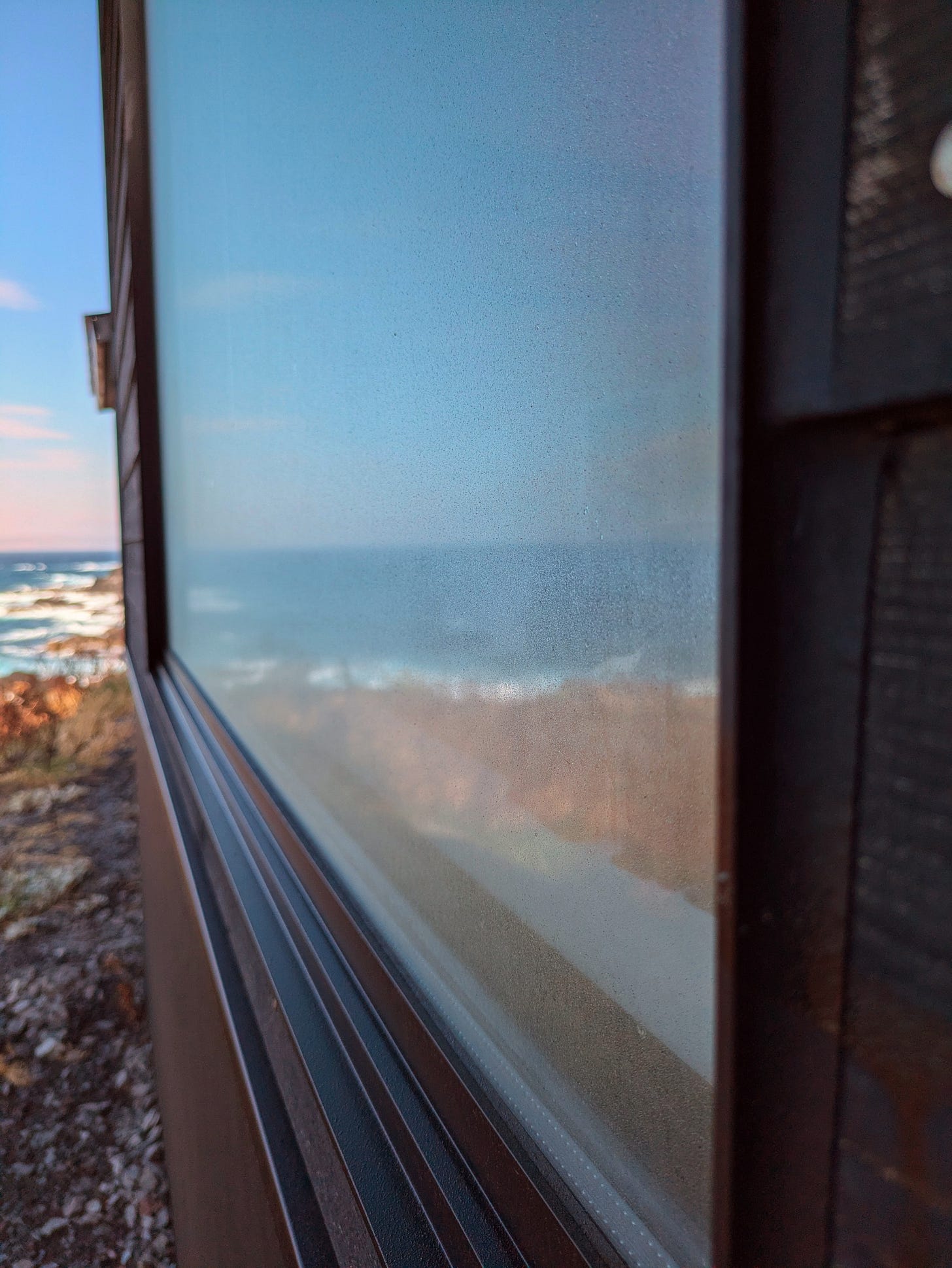Hey, I’m Casey. Welcome to our newsletter, sharing the startup journey of Kamui Whisky K.K. We’ve been busy, but when we aren’t overwhelmed, we’ll share a story as we craft up a whisky distillery on a remote, frozen, volcanic island in the most northern part of Japan.
Wind ages whisky.
That, or something close to it, is what Masateru Taketsuru, the founder of Japanese whisky, would tell his young grandson1.
Wind is everything here. It shapes us. It shapes our whisky.
The whisky made here at Kamui, at our Rishiri Distillery, is a wind-soaked embodiment of Taketsuru-san’s aphorism.
Our remote distillery is also the closest whisky distillery to the ocean in Japan. You could basketball shot a rock into the ocean from our front door. Not one of those heaving shots from half-court—but a gentle free throw.
The Umami of Konbu
There is no konbu (kelp) in our whisky. No salt, either (at least, none added by human hands).
But refined palates—whether experienced whisky drinkers or chefs—often taste the ocean. “It tastes like ‘port’” (not the fortified brandy type, but rather the depth of a fishing port) is a common observation. The more Japanese palates pick up the umami. Probably because they are more used to what umami tastes like. They understand konbu as a key source of umami in Japanese cooking, and that our distillery, just meters from the ocean, is surrounded by Japan’s most sought-after konbu beds.
Our whisky has only 3 ingredients: malted barely, water, and yeast.
It is the wind that brings these added flavors into our spirit and somehow it gets into Kamui Genshu, our new make spirit.
At first, I thought it was the wind coming in through our open doors. Sometimes, when the front tasting room door and the back shutter are both open, a vacuum is created, drawing in the south wind, whipping it through our space and out through the larger back shutters.
Or maybe it’s through the fans. Pressure-operated fans high up on our walls constantly spin, even though they’re sheltered by covers on the outside, in an inverse ‘L’ shape, that limits direct wind flow.
Our Head Distiller, Javier, pointed out2 that sometimes our malted barley will sit outside, in stacks, for hours. It gets hit by the wind. That wind, coming up off the ocean just a few meters away, is filled with salt and the umami essence of konbu, coating the malt before it even enters our distillery.
In summer, konbu is dried every day. Spread out on fields to our south and southeast, this drying konbu could be another source of our umami flavor. The south wind—our frequent visitor—picks up subtle compounds from these fields, stealthily brings them into our distillery, and gently enhances our spirit.

The Wind is a Daily Force
In this season, when you walk outside your pace might unexpectedly pick up. The wind from behind pushes you along, adding another half-step to your gait.
It is a force. It’s a rare day when the wind at our Rishiri Distillery is calm.
Most days of the week wind gusts at speeds of 40+ km / hour.
Not infrequently gusting at 80+ km / hr.
If you're geeky and want to follow our wind, you can download and follow us on Windy.app. Our distillery is tagged. You can see our live wind speeds and direction here3.
Pro-tip: If you’re visiting with kids, go for a vehicle with sliding doors! Standard doors can catch the wind, slamming open hard and fast enough to smash and properly dent up a neighboring car. Trust me, I’ve had this happen more than once. Having to call the cops, make a long statement, and apologize to the car owner who had their car all scratched up, while shivering in the cold, gusting wind!
The Wind Leaves Physical Marks
Wind here isn’t just a presence; it’s a force that leaves physical marks everywhere.
On our windows:
These windows are washed almost daily. Lots of elbow grease is spent to get them clean, but by morning, the salt is back. It’s a real-life Sisyphean task.
Flying foam:
The foam gathers in big, foamy pools down at the volcanic rock coastline. The wind lifts the foam high into the air, floating past our big bay windows, down walkways, and even reaching the parking lot.
On cars too, the wind leaves its mark.
Of course, rust is a problem. A subtler, daily problem, though, are windshield wiper blades. If the blades aren’t the right type, nor quite new, they become useless at cleaning the salty residue off the windshield. You can squirt ton after ton of washing fluid on the window, but the salt in combination with weak wiper blades just smears the windows with more salty residue, making driving a real challenge.
And the even subtler problem is this happens multiple times a day. But, by the fourth time of the same day you’re not very motivated to once again clean the windows in the cold. Which means you’re driving around with lowered visibility. Not the safest.
The Wind is a Barrier
When it gets blowing the wind acts as a moat. It keeps you off the island, or it can trap you on the island. Flights get cancelled4, but ferries seem to be cancelled even more frequently. In winter and the shoulder seasons, you can get caught on (or off) the island for days at a time.
Our friends at Heartland Ferry5 kindly shared real data about this year’s ferry cancellations:

If the wind is over 25 km / hr, or the waves exceed 4 m, then a ferry will be cancelled. I’ve been on a couple of ferries close to those levels, and it often results in mad rushes to the bathroom of green-faced people trying to keep it in from about halfway through the trip onwards.
Not listed here are November and December, but those months, along with January are the worst for the wind. Last year there were 13 days in those two months when all ferries were cancelled. Basically, no way off the island.
This additional layer of remoteness, not only geographical, adds to the uniqueness of our Rishiri Distillery.
Capturing the Wind
Our whisky will very naturally, simply by aging, capture the wind. But, for the label of our first Japanese Whisky release, in 2025 Fall / Winter, we will have about 800 bottles (such a small supply!!!), the theme I’ve been trying to have captured on our label is the Wind. But, it has been so hard to do.
How do you capture the wind graphically? It’s got to be moving something. Trees? Leaves? Those are the usual ways, but trees are not such a main component in the aging of our whisky. With water, and the ocean, it would be waves. But, Hokusai already did this so well 🌊.
We’ve been collaborating with an incredibly talented global artist and top Japanese designers, but it has still been a big challenge. It has tested their creativity, skills, and perseverance.
We’re getting closer to designing our first label for our first Japanese whisky, though we are not quite there yet. Capturing the wind is elusive.
Un-copy-able
The variables are immense, too hard to make any sort of calculation. It really is nature. It really is Rishiri making our whisky.
The direction of the wind affects what it brings: from the South, it brings the ocean; from the Southwest, the kelp beds; from the Southeast (in the summer), the drying kelp flavors; and from the North, grasses, flowers, and some tree components.
The intensity of the wind will also change how deeply it penetrates our distillery, our spirit. On days we barrel whisky, we leave the barrel outside for a couple of hours. If the wind is very strong it will get those salt tastes and konbu (of course depending on wind direction) deep into the wood of the barrel.
The intensity of the wind will also change the compounds and size of the compounds being carried by the wind. In subtle ways, that I have no idea of how to scientifically explore, it will change the taste of our whisky. It’s much windier now than it was in the summer. Kamui Genshu made in the fall, may be saltier, with richer umami than Kamui Genshu made in the summer.
It will hit, and get inside our aging warehouse thousands of times before our aged spirit is ready to be harvested as Japanese Whisky.
All of these factors from the wind will make each batch, each season of our Kamui Genshu and our Japanese whisky, uniquely complex. The constant, though, is that the salt, the port-like taste, and the umami of the konbu will be there.
When you taste our whisky, and if you share your thoughts on the flavor with whomever you are drinking, mention the taste of umami, how it tastes like it is aged by wind, that you can taste the terroir of Rishiri - you won’t be wrong!
The Wind Feeds
My 2 year old, and one of our very smart distillery crows6, were using the wind to share snacks:
The grandson, now a famous grandee in the industry here, has been a wonderful mentor and friend.
Javier also pointed out that the AC smells like the ocean when you turn it on after the weekend.
Seems you can listen with the sound on. There is a button on the right to turn on the live sound. Pretty cool.
Flights seem to get cancelled less often than ferries. I didn’t extend any journalism skills to get information from JAL who has the regular flights to Rishiri. By feel, it seems they are cancelled more because of visibility issues, low clouds stuck on the mountain, rather than wind. There have been some, bumpy, more-than-a-roller-coaster exciting landings into Rishiri. I’ve had a couple where the plane was pretty much sideways until the last moment when the pilot would straighten it out for landing.
Very big thanks to our partners at Heartland Ferry for sharing this data so readily. 🙏🏼🙏🏼🙏🏼
We’ve got some real foodie crows. They daily eat our nutritional draff, rich in fibre, proteins and oil, as it dries out outside. They recognize the faces and the timing of when they will get fed, and a couple of them are always ready, and so, so fast when their “feeding” time comes.






